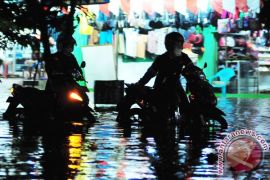Some reservoirs in the country are in a critical condition while others are also undergoing degradation due to heavy contamination on account of domestic refuse and silting due to soil erosion.Jakarta (ANTARA News) - Indonesians, like most other people in the world, love to go out for a picnic to unwind at tourism resorts or at other destinations such as lakes after a long and hectic week of working.
Lake Toba in North Sumatra is a famous natural tourism destination in the country, apart from the Saguling, Cirata and Jatiluhur reservoirs in West Java. Lakes and reservoirs, if cultivated optimally, have numerous economic benefits, including in the tourism sector.
Indonesia has over 800 reservoirs which can potentially be developed as tourist destinations for holidaymakers and picnic lovers.
Unfortunately, some reservoirs in the country are in a critical condition while others are also undergoing degradation due to heavy contamination on account of domestic refuse and silting due to soil erosion.
Therefore, Indonesia needs to rehabilitate its reservoirs or even develop them into tourism destinations. This will benefit the people economically. The regional government of Lebak District in Banten Province, for example, is now offering investors to develop its reservoirs as tourist destinations.
"We have at least three reservoirs that could be developed as tourism destinations, namely the Palayangan, Cicinta and the Cilemer reservoirs," Jumono, the head of Lebaks Dam and River Affairs Service, stated on Tuesday.
The dams also have a tourism potential, as they offer beautiful natural panoramas with gentle breezes. Around the reservoirs, there is usuallu a forest cover with tall trees and an abundance of birds.
"We hope the lakes could be developed and the dams are transformed into tourism destinations to boost local economic activities," Jumono added.
Indonesia has 840 reservoirs or lakes which have high economic and ecological value. It is not only the locals who will benefit from these reservoirs but also foreign tourists who visit them.
Some of these reservoirs are facing acute problems on account of pollution from domestic waste, floating fish cages, upstream erosion of land and degradation of their biodiversity. At many reservoirs, the water surface has been covered by water hyacinth.
Lakes or reservoirs have many functions. Locals earn a living by cultivating fish and fulfill their water needs. These also provide hydro power and become a place for locals and foreign tourists to visit.
However, these functions are being threatened due to the degradation of the reservoirs surrounding environment.
In order to ensure that reservoirs fulfill all their functions, what is needed is a commitment by everyone, including the regional government and the people. Since 2009, an agreement arrived at by nine ministers has been in force to develop and manage sustainable reservoirs.
At least 15 reservoirs in a critical condition are receiving attention on priority in the governments reservoir salvation program. "It should be managed based on the principle of ecological balance," Arief Yanto of the Ministry of Environment and Forestry, was quoted as saying by Tempo.co online media last year.
Indicators of critical lakes included the silting of lake bed due to soil erosion and the growing of various plants such as water hyacinth that caused the drop of the lakes water. The efforts to restore the lakes healthy conditions would be made through a short and long term scheme.
In the short term, the reservoirs would be cleaned from water hyacinth plants because the trash from hyacinth was big and could affect the reservoir water.
In Jakarta and environs at least 200 dams are also in degraded conditions. Some time ago, the Environmental forum ,Walhi, suggested that government should renovate at least 200 dams in Jakarta and surrounding areas so that they would be able to contain excess water from heavy rains in upstream areas.
The revitalization program needs to be coordinated immediately between the National Development Planning Board (Bappenas) and the Ministry of Public Works as well as with the regional governments of Jakarta, Bogor, Tangerang and Bekasi (Jabodetabek).
The program should be carried out immediately, particularly for dams whose downstream areas were residential regions. The other solution that could be pursued to overcome possible natural disasters is to stop the conversion of river basin (DAS) and water catchment areas into land for development projects or other purposes.
The change in the function of water catchment areas had caused the decline in the number of reservoirs in the Jabodetabek region. According to Walhi, at least 56 lakes had disappeared due to failure to conserve them.
The number of dams in the Jabodetabek area has declined from 240 in 2004 to 184 in 2009 while the government always claimed that there are over 200 lakes at present.
Of the 184 dams, 19 are still in good condition while the remaining ones are now experiencing serious sedimentation and damage. In term of width, the 240 reservoirs in the Jabodetabek areas have also decreased from 2,337.10 hectares to 1,462 hectares (184 dams).
The average depth of the reservoirs also has dropped from the previous 5 to seven meters to less than 2.5 - 3 meters. Three main factors have caused the disappearance of the lakes, namely the change in the function of land, the lakes being used as garbage dump sites and sedimentation.
Change in the function of land has caused the dams to be converted into resettlement, restaurant and business centers.(*)
Reporter: Andi Abdussalam
Editor: Heru Purwanto
Copyright © ANTARA 2016








